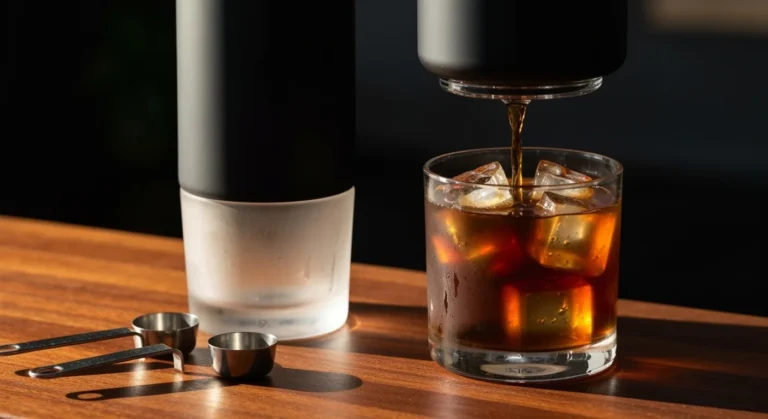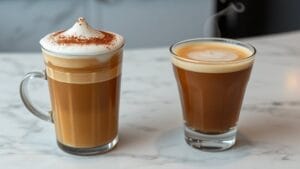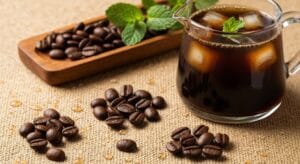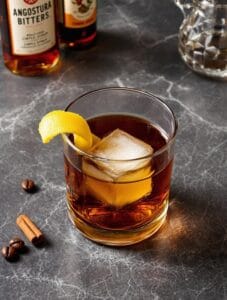Cold Brew Caffeine Myths vs Reality
Cold brew’s caffeine myth parade is so loud, it drowns out common sense, and it’s time to pop each silly balloon.
Cold brew caffeine content isn’t magic; ratio and dilution decide the dose! People ask, “does cold brew have more caffeine,” yet forget the jug gets watered down before sipping.
Caffeine numbers aren’t conjured by the fridge—how strong you brew, then how much water you splash in, sets the punch you feel.
Hot water pulls caffeine like a sponge, so undiluted concentrate can top hot drip, but once ice splashes in, the cold brew vs iced coffee caffeine gap shrinks to a rounding error. Additionally, the specific brewing method plays a crucial role in determining the final caffeine content.
When refrigerated cold brew sits in an airtight container, it can retain potency for up to ten days, but frequent unsealing lets flavor—and perceived caffeine punch—fade.
Bean type, roast, scoop size—those juggle numbers far more than temperature ever could.
Stop blaming cold brew for rocket-jolt jitters; blame the barista who poured a triple-strength pint with a smile.
How Much Caffeine Is in Cold Brew Coffee
Most mugs of cold brew plop down somewhere between 120 and 270 mg of caffeine—think “Sonic the Hedgehog with antlers!”—but every once in a while a bottle swings as low as 9 mg or skyrockets past 330 mg!
The wide scatter happens because homemade brews, big-chain cups, and corner-store concentrates all tinker with bean-to-water ratio, steeping hours, and even the simple size of the cup, so tiny tweaks flip the final kick. On average a 16-ounce Starbucks cold brew delivers about 205 mg, right in the middle of the range.
Typical Cold Brew Caffeine Range
A single 12-ounce cup of cold brew usually drops in at about 207 milligrams of caffeine, which is enough to rocket most folks into orbit (though sometimes the landing is softer, at 109, or wilder, at 285 mg!).
This typical cold brew caffeine range shows just how punchy cold brew can be! On the smaller side, an 8-ounce homemade mug might hold 80–200 mg, and store-bought bottles swing from a gentle 9.5 mg all the way up to a wild 330 mg per serving.
Wondering the exact amount of caffeine in cold brew? It’s all over the map!
Why Cold Brew Caffeine Varies So Much
Because a cold brew is just chilled water hanging out with ground coffee for ages, the caffeine count can swing like a monkey on espresso—so why the crazy gap?
First, cold brew coffee caffeine content leaps or shrinks based on the coffee-to-water ratio; more beans equal more buzz.
Next, brewing method and extraction dynamics switch things up: coarse grind plus long cool soak pulls caffeine slower, whereas finer grind or a quick shake yanks more out.
Lastly, steeping time duration is boss—12 hours keeps caffeine calm, 24 hours kicks it up, and 48 hours sends it sky-high (but tastes bitter, yuck).
Smaller grinds, hotter room temps, stronger concentrates, or giant cups all turn the dial too; every tiny tweak rewires the shot!
Cold Brew vs Other Coffee Drinks: Complete Comparison

How much more kick could cold brew really pack compared to your usual cup of joe? Swap your latte, hot drip, and shaken espresso for a full mug of cold brew, and giants like Dunkin’ can hand you 260 mg cold brew coffee caffeine while a teeny 1 oz espresso drip holds only 63 mg, so does cold brew have more caffeine than espresso? Yep, way more! cold brew vs iced coffee caffeine tests also show cold brew beating 165 mg iced pots, so the tall cup wins.
compare quick
—|—
Cold Brew (12 oz) | 207 mg
Espresso (1 oz) | 63 mg
Iced Coffee (16 oz) | 165 mg
What Actually Controls Caffeine Levels in Your Coffee
Cold brew’s buzz size depends on big-picture things: the bean (Arabica is gentle, Robusta is like rocket fuel, and a roast makes beans shrink, not lose kick). Additionally, espresso contains more caffeine per ounce than many other brewing methods, so the type of brew you choose significantly impacts your caffeine experience.
Next, the way it’s brewed—slow cold steep, fast espresso blast, or just-right drip—plus finer or chunkier grinds, trickier recipes, and the wildcard tricks each brand hides in the label decide if your cup feels like a kitten purr or a drum solo. Additionally, the coffee-to-water ratio significantly influences the resulting caffeine levels in your brew.
Brewing Method and Time Effects
Most days, the amount of caffeine swimming around in your cup is ruled by two big bosses: the way the water meets the grounds, and how long those grounds get to chill with the water.
Cold water creeps, taking 12–24 hours, so how much caffeine does cold brew coffee have? A lot! The brewing time and caffeine content relationship means those lazy hours let caffeine drip, drip, drip until cold brew caffeine mg tops espresso shots that race in three quick minutes. Additionally, the process of brewing coffee affects the extraction of caffeine, as demonstrated by the mechanics of the Moka pot.
Longer steep equals more buzz; 18 hours is the sweet spot, after that caffeine gains slow like a snail on a nap break. Additionally, longer steeping times can enhance caffeine content in tea, providing insights into how brewing methods impact overall caffeine extraction across various beverages.
Coffee Bean Type and Roast Impact
Steeping time and water dance get the headlines, yet the quiet giants are the beans, like tiny caffeine suitcases packed way before they ever meet water!
Coffee bean species and caffeine content differences decide the show: robusta beans hold double caffeine of arabica beans (roughly 2.2% vs. 1.1%), so swapping beans flips any cup from gentle to rocket fuel with zero extra work! The high genetic diversity of robusta contributes to its unique flavor profiles and robust growth in varying climates. Additionally, the average caffeine concentration**** of various roasts emphasizes how fundamental bean choice is to energy levels.
Influence of coffee roast level on caffeine concentration is minor; dark roasts lose water mass, not caffeine, so scooped spoons of dark beans may give slight volume enhancement yet the base gap is species initially, roast subsequently.
Keep brewing weight constant, and the concentration of caffeine in coffee beans vs. brewed coffee maps straight onto your mug like a math sticker!
Brand Differences and Preparation Variables
Right out the gate, every brand swears their cold brew is “the strongest,” yet the numbers tell a wild story! Starbucks 16oz cold brew caffeine clocks 205mg, Dunkin’ jumps to 260mg—same cup, brand differences in caffeine content right before your eyes!
Cold brew coffee vs regular isn’t a secret handshake; it’s coffee-to-water ratio, grind size, steep time, and dilution choices. Some companies steep 24 hours, others stop at eight—more hours equals more caffeine. Additionally, the type of bean variety used impacts the overall caffeine content, as Robusta beans contain nearly double the caffeine of Arabica. Others sell concentrate, others pre-dilute—like buying soup instead of stock, and your cup ends up with half the punch! Additionally, brewing methods play a significant role in determining the caffeine levels in your favorite cold brew.
How to Choose the Right Caffeine Level for Your Needs
Choosing the right caffeine level isn’t rocket science—it’s just about matching the drink to what the body can handle and what the day demands.
- See: how much caffeine in cold brew sits between 150–250 mg per 12 oz—yep, does cold brew have more caffeine than iced coffee by about 30-50%!
- Match caffeine levels to lifestyle and health goals like light buzz at 100 mg for easy mornings or full rocket 200 mg for garage-project nights.
- Watch weight, meds, pregnancy, sleep hours; when in doubt, pick the smaller cup and skip additional servings.
- Many coffee brands, particularly those using Robusta beans, offer extreme caffeine levels that can significantly impact your energy levels throughout the day.
Key Takeaways: Your Cold Brew Caffeine Decision Guide
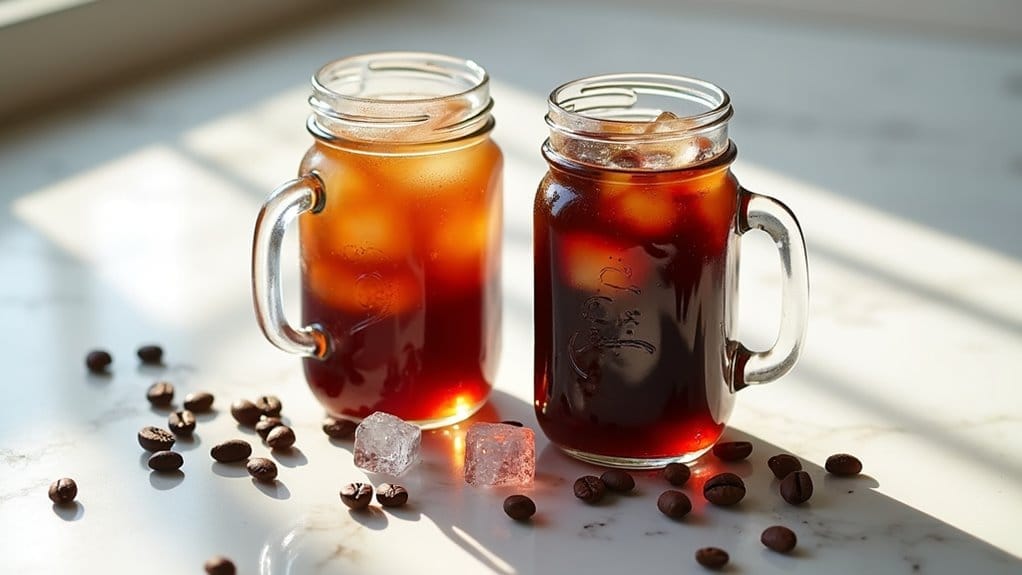
So you’ve eyeballed the menu, picked the gentle buzz or the full rocket, and you’re standing in line—awesome!
- Cold brew coffee vs iced coffee caffeine: 200 mg in cold brew, 165 in iced, clear win!
- How much caffeine in a cup of cold brew: about 200 mg in 16 oz, sip wisely!
- Is cold brew stronger than regular coffee: depends, but often yes, rocket fuel vibes!
- Serving size = power lever: bigger cup = bigger blast, simple math!
Frequently Asked Questions
Does Cold Brew Expire Faster Than Hot Coffee?
Like fog thinning beneath sunbeams, storage difference reveals cold brew persists refrigerated for weeks; hot coffee expires within hours, oxidizing rapidly, hence proving cold brew does not expire faster than hot coffee.
Can Cold Brew Cause Anxiety Like Energy Drinks?
Anxiety occurrence mirrors energy drink severity contingent upon cold brew dose; heightened milligrams trigger cardiovascular stimulation, parallel symptoms emerge. Additive absence offers potential moderation, individual sensitivity dictates variability.
Is Decaf Cold Brew Actually Caffeine-Free?
No. Decaf cold brew retains trace caffeine, around 15 mg per serving. Decaffeination removes approximately 97%, leaving residual amounts detectable in analysis, contrary to “caffeine-free” claims of commercial products.
Does Cold Brew Stain Teeth Less Than Drip?
Quantitative assays reveal 60% less tooth staining from cold brew versus sweetened drip. Analysts attribute milder discoloration to reduced acid, diminished polyphenols, and absence of heat in prolonged cold extraction kinetics.
Can You Warm up Cold Brew Safely?
Warming cold brew safely involves stovetop low heat without boiling to 60-70 °C. Small portions, gentle stirring, and avoiding microwave or boiling preserve its original smooth, mellow, and non-bitter flavor profile.

